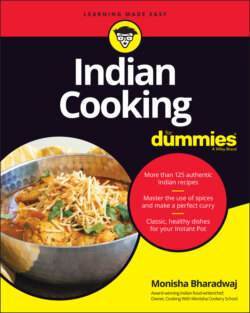Читать книгу Indian Cooking For Dummies - Monisha Bharadwaj - Страница 14
The influences that make Indian cooking so diverse
ОглавлениеWith so many regions, it’s easy to be perplexed by the variety in Indian cooking. If I tell you that India is a vast country, you may reply that there are many other vast countries in the world. That’s completely true, but none has a cuisine that changes every few miles. Here are the reasons Indian cooking is so diverse:
Climate: You may think that all of India is a hot country because it’s in a tropical part of the world, but there are many places in the country that are cold enough to experience snowfall. When we’re in a hot place, we want to eat cooling foods, like ice cream. But it’s India, so we’ll talk about spices. Chilies contain a compound called capsaicin in their membranes; capsaicin is what makes them hot, but when we eat them, capsaicin also makes our blood vessels dilate and makes us sweat. Have you seen some people mopping their foreheads when eating a hot curry? Sweating helps us cool down, and that’s why in hotter parts of India such as the South, which is nearer the equator, recipes have lots of chilies. You’ll find milder curries spiced with pepper in the colder regions.
Geography: In such a big country, eating local food and not paying for transport costs is definitely cheaper. Local recipes make the most of ingredients that grow close by, so you’ll find coconut-based curries in the South and wheat breads in the North. The desert state of Rajasthan uses few fresh vegetables. The ones that do grow are dried and cooked with fiery spices to combat the searingly hot and dry climate. The availability of water is a big contributor to food diversity. In fertile regions that are fed by rivers and seas, more crops can grow. Similarly, there are a variety of soil conditions all over India — the rich black soil of Western India supports the growth of millet, whereas the alluvial soil of Punjab in the North is good for wheat.
Religious beliefs: India is home to many major religious groups. Growing up in cosmopolitan Bombay (as Mumbai was then called), I had Hindu, Muslim, Jain, Christian, Jewish, and Buddhist friends, and we all celebrated each other’s festivals and foods. We knew that some Hindu friends would be vegetarian, whereas others would eat meat but never beef. Our Muslim friends didn’t eat pork. The Jains didn’t eat root vegetables (their way of life is based on nonviolence, so killing of life forms by uprooting vegetables is prohibited). The cuisine of each community is based on these religious beliefs and meant that I was eating vastly diverse foods from when I was quite little.
Trade, migration, and conquest: I don’t like to use the word authentic when speaking about Indian cooking. Although the cuisine is ancient, there are so many foreign influences that make it what it is today. (I explain more about this concept in the sections that follow.) At the heart of the cuisine is the world’s need for India’s spices and what each of the foreign powers brought with them in exchange. Pepper, the spice that started it all, is said to have changed the history of the world.
